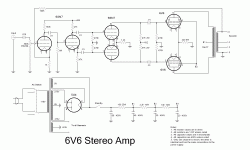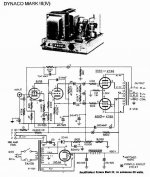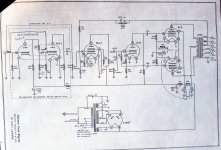The speakers you have seem to be bi-ampable. You may want to consider running the woofers with your SS amp, and building a lower powered tube amp for the mids & tweeters. Just throwing that out there.
That makes sense, and as an example, the Dyna Stereo 35 amp with EL-84 tubes would be nice, and it's a kit.
Lots of people like the mids/high end from this amp. You could later replace the driver boards if you like.
ST-35 KIT (120 VAC)
Or, much cheaper, you could modify a used Dyna SCA-35 integrated amp for use as a power amp. Similar amplifier stage.
Last edited:
As far as building an amp, I'm on the DIY side of the fence. You have the background and the ability to build hifi amp. Deciding what to build may take a while, which seems to be ok with you.
The speakers you have seem to be bi-ampable. You may want to consider running the woofers with your SS amp, and building a lower powered tube amp for the mids & tweeters. Just throwing that out there.
jeff
Wow, that's interesting. I have a 200W Acurus right now that I won't know what to do if I have a new amp. It's not the worst in the world as is. You think that is good enough for the Woofer? BTW, I am using a Valodyne Sub Woofer, I am happy enough with that, so I am not planning to do anything about that.
Yes, the speaker has an input for mid and treble, then separate for Woofer. So it is definitely doable. My question is whether I need to worry about the phase matching between the two amps. I understand the inverted and non inverted part, how about the phase shift between the two amp with frequency?
I particular like this idea that I can add to the existing setup, not throwing away the Acurus and I can easily A/B compare.
Last edited:
Yes, the speaker has an input for mid and treble, then separate for Woofer. So it is definitely doable. My question is whether I need to worry about the phase matching between the two amps. I understand the inverted and non inverted part, how about the phase shift between the two amp with frequency?
Phase shift is a necessary part of the crossover network. You can just use a passive RC filter before the amplifier for the lows,
and a passive CR filter before the amplifier for the highs, both set to the same frequency. Of course you would need to take into
account the input/output impedances of the preamp and power amplifier when designing the RC filters.
Most amps do not invert polarity. You will also need to match the gains for the lows/highs.
Last edited:
That makes sense, and as an example, the Dyna Stereo 35 amp with EL-84 tubes would be nice, and it's a kit.
Lots of people like the mids/high end from this amp. You could later replace the driver boards if you like.
ST-35 KIT (120 VAC)
Or, much cheaper, you could modify a used Dyna SCA-35 integrated amp for use as a power amp. Similar amplifier stage.
Thanks, So you think this low wattage is good enough for driving the mid and treble?
Is my eye playing a trick on me? I don't see the price of the kits on the site!!!
Do you have other site that sell high quality kits and transformers?
Thanks, So you think this low wattage is good enough for driving the mid and treble?
Is my eye playing a trick on me? I don't see the price of the kits on the site!!!
Do you have other site that sell high quality kits and transformers?
You have to select the option from the pull down menu. Bear in mind that this is a 15-20 W/channel amp.
The internet is big, and I'm sure there are lots more possibilities.
Last edited:
OK, that's the really true reason for me looking into building the amp ( if it is feasible). If I go out and spend $2000 for a used amp, my big boss ( wife) is going to give me an instant review and it's not going to be diplomatic. But if I buy things $100 at a time like I do in my guitar amp, spreading out a little, so far she's ok on that!!!! I am sure those of you that have a big boss to answer to can sympathize with this!!!!
But this is really at a thinking stage, sounds like it's not as easy as guitar amp that we buy new parts and build.
I can understand this, however that doesn't really tell us what kind of a design you're looking for.
I still say it's best if you do experiments first. You could potentially end up saving a lot of money. Experiments are cheap and enlightening.
ThanksYou have to select the option from the pull down menu. Bear in mind that this is a 15-20 W/channel amp.
The internet is big, and I'm sure there are lots more possibilities.
I saw the A and B option, I did not click it!!!! The price is quite reasonable.
I have a question. What is the reason all the schematics I've seen ( very few) use tube rectifier. Is there a disadvantage of using diode rectifier. In guitar amp, people use tube rectifier to get sag mostly for distortion. But in hifi world, you don't really go for distortion.
Also, another thinking is I have a few power transformer for 100W guitar amp that can power 4 6L6. But it's for SS. I would have to buy a separate 5V filament transformer for the rectifier tube. If I build from scratch, I might be able to use the power transformer I have for a 40W per channel amp. Then I buy two output transformers. Find a rack mount chassis and build on it.
I am just going around and around, I don't exactly what to do, which way to go. I can definitely drill my own chassis, it's going to be in a cabinet with closed door, so looks is not important at all. I just need to open the back of the cabinet to improve circulation.
Last edited:
Since you spoke about Cary, here is the internal wiring of the SLI-80. Could you replicate that and have it working as it should (no hum, no oscillations)
The question I am afraid is whether there is anything more to the layout than to avoid oscillation and ground loop. That's the kind I am afraid because in guitar amp, there are times they intentionally couple with wiring to get a certain sound!!!! That gets a little into the mojo or magic arena!!!
I don't know the schematic, so I can't trace it out. But if wiring and layout is mainly to avoid crosstalk ( causing oscillation), and hum due to grounding, I think I can do it. I did a lot of high speed, high gain and low noise pcb and system wiring designs. I worked as RF and signal integrity engineer for a long time. I think I am familiar with layout.
In instrument amps, a high impedance PSU is desirable for sag and compression, as you said. In hifi a low impedance PSU is preferred, for lack of compression and sag. Regulation is widely used for B+ and other supplies.
Then SS rectifier is superior than tube. Using over rated power transformer and low ESR cap should help. That's the part I am confused, using a regulated PS should even be better then. In guitar amp, even if we use SS rectifier, we put a 200 ohm resister in series to create the sag!!!
Yup! That's why I only use the 5Y3 for the most sag in instrument amp building. Contemplating this 1st schematic. The other 2 may be of use. I like the "phase spliter" idea of splitting the negative half off from the positive half, and thus directly into the Push-Pull final section. But like everyone says, the Pre-Amp is everything. You should read Frank's (BV Audio) thread. here... http://www.diyaudio.com/forums/tubes-valves/12042-franks-ultimate-tube-preamp.html ....and he is still on here now & then, and willing to help A+ too.
There is so much good information to read here on DIY Audio (Thanks Members) And thanks OP for starting this most popular thread, there are many, many others with exactly the same question. And with some an actual outcome!
Doug
There is so much good information to read here on DIY Audio (Thanks Members) And thanks OP for starting this most popular thread, there are many, many others with exactly the same question. And with some an actual outcome!
Doug
Attachments
I thought the power amp is the most important!!! I bought the Acurus before the JM Lab, I bought the Acurus to match the Kef floor speaker I had before. Later when I was buying the JM Lab, I brought the Acurus over to test the sound, I compare with a YBL SS amp, it was day and night difference. We had the same preamp, using the same CD and the JM Lab in the same room A/B comparing, so the difference is all on the power amp. The difference is as big as between the Kef and JM Lab speaker.Yup! That's why I only use the 5Y3 for the most sag in instrument amp building. Contemplating this 1st schematic. The other 2 may be of use. I like the "phase spliter" idea of splitting the negative half off from the positive half, and thus directly into the Push-Pull final section. But like everyone says, the Pre-Amp is everything. You should read Frank's (BV Audio) thread. here... http://www.diyaudio.com/forums/tubes-valves/12042-franks-ultimate-tube-preamp.html ....and he is still on here now & then, and willing to help A+ too.
There is so much good information to read here on DIY Audio (Thanks Members) And thanks OP for starting this most popular thread, there are many, many others with exactly the same question. And with some an actual outcome!
Doug
A friend of mine actually told me to get rid of the preamp and use a multiples switch box and a potentiometer and drive from DVD player directly into the power amp.
Also, the few hifi power amp schematic I saw use paraphase PI instead of long tail differential pair so commonly used in guitar amp. Is there a reason for that? I thought the long tail differential pair is better.
Last edited:
I have a question. What is the reason all the schematics I've seen ( very few) use tube rectifier. Is there a disadvantage of using
diode rectifier. In guitar amp, people use tube rectifier to get sag mostly for distortion. But in hifi world, you don't really go for distortion.
You can use silicon rectifiers if you turn on the filaments first, and delay the HV for 30 seconds.
This avoids cathode stripping of the tubes and over-voltage on the filter caps.
Last edited:
Then SS rectifier is superior than tube. Using over rated power transformer and low ESR cap should help. That's the part I am confused, using a regulated PS should even be better then. In guitar amp, even if we use SS rectifier, we put a 200 ohm resister in series to create the sag!!!
What's the confusion?
A friend of mine actually told me to get rid of the preamp and use a multiples switch box and a potentiometer and drive from DVD player directly into the power amp.
If you need a low impedance output to drive the amp, this wouldn't be a good idea at all.
I thought the long tail differential pair is better.
It is.

You can use silicon rectifiers if you turn on the filaments first, and delay the HV for 30 seconds.
Or just use a thermistor after the diodes.
jeff
Or just use a thermistor after the diodes.
Won't work here. Those are for current surges, not voltage surges.
Last edited:
If you need a low impedance output to drive the amp, this wouldn't be a good idea at all.
It is.
Or just use a thermistor after the diodes.
jeff
If long tail differential pair is better, it can have very high input impedance ( set by the resistor from grid to ground.) You can use a 1M which is common in guitar amps. With that, using a potentiometer and skip the preamp should be possible.
What's the confusion?
The very few schematics I saw in hifi power amp use tube rectifiers.
- Status
- Not open for further replies.
- Home
- Amplifiers
- Tubes / Valves
- Need suggestion in building a stereo power amp


